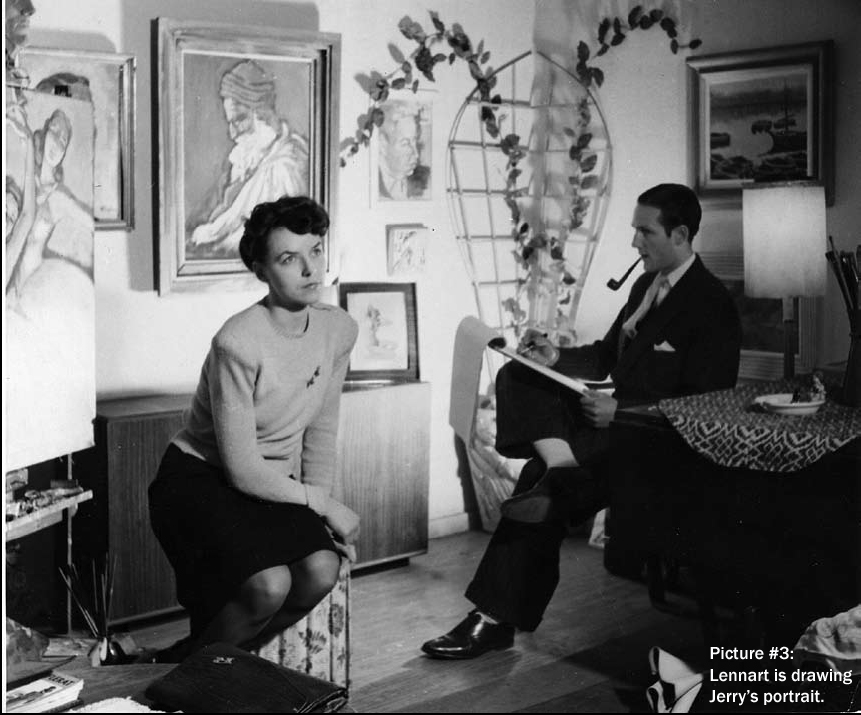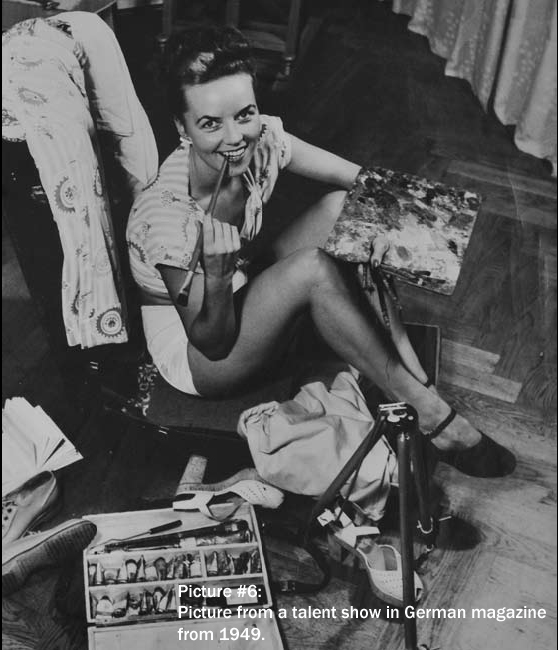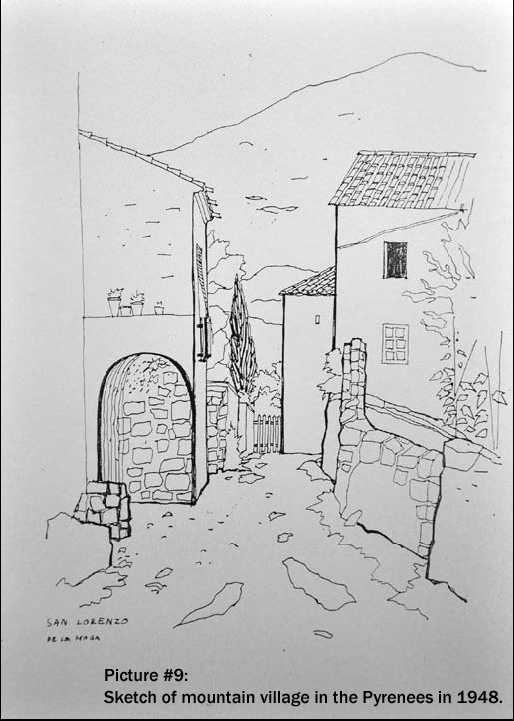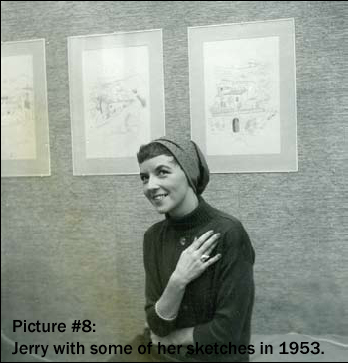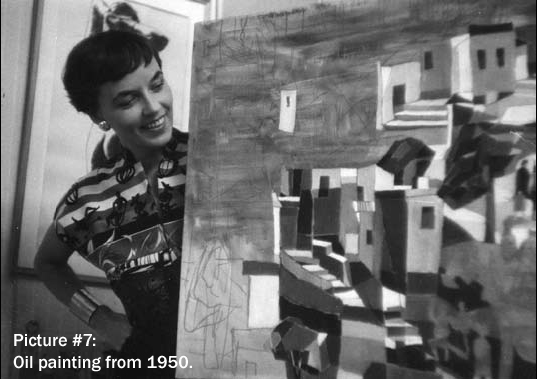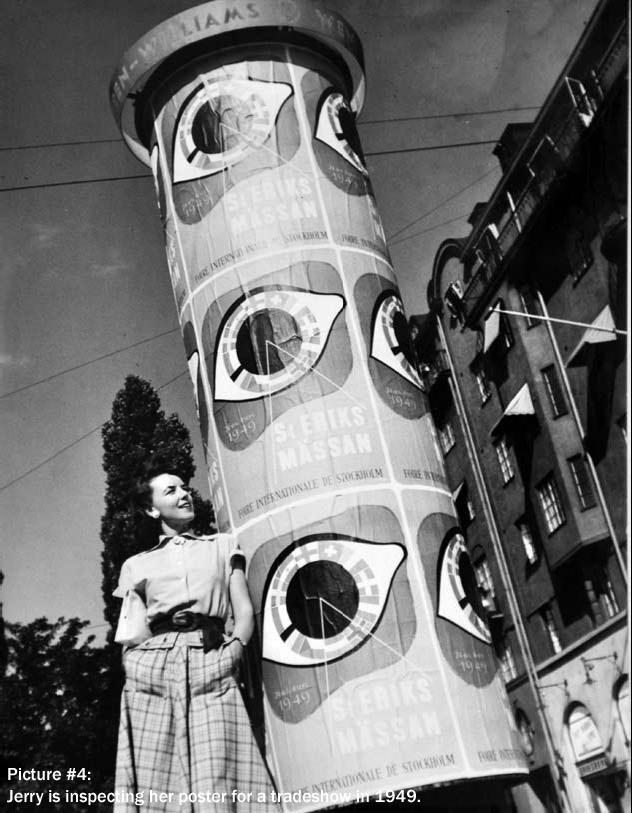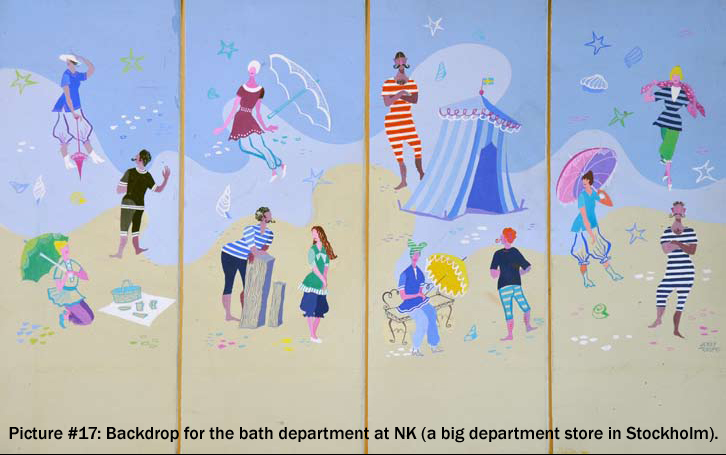Biography
Jerry Roupe 1919 – 2005
Jerry Roupe was an incredibly talented artist with a huge portfolio.
She was born in Stockholm in 1919, one year after the end of the
First World War. She loved the city all her life. The years after the war
in Sweden brought hard times for the city folk with rationing, lack of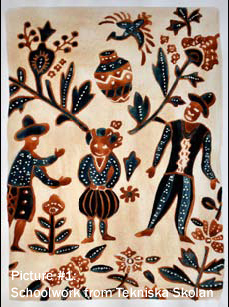
food, and unemployment. One had to be somewhat of an inventor to
survive the every day life. Jerry learned early on to view life’s obstacles
as problems to be solved instead of impossible challenges.
When Jerry was an adolescent she already knew that she wanted to
“create pictures.” She was also very athletic, and some of her favorite
sports that she excelled in were gymnastics, swimming, paddling,
throwing the javelin and especially cross country skiing. But creating
art was her main passion.
1930´s
When she was 16 years old Jerry started her artistic education and she
attended one semester at the Tekniska Skolan (now called Konstfack).
One semester was enough she decided. She thought that everything
that was taught at school she already knew and it was moving at a
much too slow pace for her. Life as an autodidact suited her much
better.
She had now started to paint with oil and tempera and she visited art
museums and art exhibitions as much as she could.
In 1937 she applied for her first job. She is now a draughtsman for a
small studio called “Tecknare på Söder” (Artists on the south side).
She was 18 years old.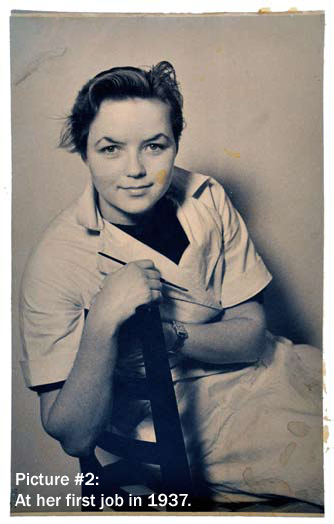
Her next job was at one of the largest advertisement
bureaus in Stockholm. She would get to know very skilled
illustrators, printers, and decorators and they were all
willing to share with her, the newcomer, all of their skills.
World War II was an undeniable fact and Jerry helped
out by traveling around the archipelago in Stockholm to
perform in a variety show for the soldiers.
Another thing that happened during the war was that the
studio where Jerry worked got a new employee. Illustrator
Lennart Roupe.
Jerry and Lennart became a couple. The war went on
longer than expected and the wedding plans they had
made had to wait, mainly because Lennart was called in
by the Swedish military numerous times. But finally, in
September 1946, their wedding took place. The young
artists were now freelancers and they started their long
life together; 59 eventful years!
1940´s
As a freelancer Jerry started to illustrate books, work on ad campaigns,
make logotypes, illustrations and so on. She also continued her artistic
work with oil on canvas. Together with her husband Lennart she also
worked at creating booths for different companies at trade shows and
art exhibitions.
In 1948 the couple made their first long trip to southern
Europe. They would get on the big freighter in Helsingborg,
Sweden and get off in Lisbon, Portugal. They
spent a few very productive months in Portugal and
Spain. This kind of traveling really spoke to them and
they would repeat it many times as the years went by.
1950´s
In 1951 Jerry and Lennart’s son Michael was born.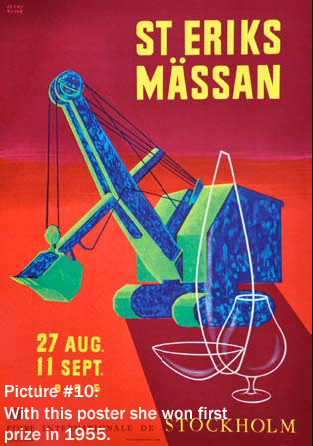
He would also become an artist. Jerry now started to
sketch more and more posters for different events and
would become one of Sweden’s best poster-artists. In
1955 there was an exhibition and competition for trade
show posters in Köln, Germany. Jerry won first prize with
her poster for Saint Erik’s trade show, nowadays called
the Stockholm tradeshow.
1960´s
In the late 1950’s and beginning of the 1960’s a new idea started to
develop.
Printed textiles in many different colors and varieties.
Flowers and leaves and fun creatures/figures printed onto tablecloths, curtains, wall hangings and runners were all filled with humor and warmth.
In 1960 Jerry created the wall hanging “Tomteparaden” (Santa Parade),
which turned out to be a huge success.
1970´s
Parallel to all her other design work Jerry has always painted with oil
on canvas. The never-ending search for new ways to express her self
lead her to what she called “Monotextiles”. It’s a form of tapestry inspired
by African dance masks, and they are often big. She would sew
the colorful details by hand and sometimes adding details in brass. At
two separate art exhibitions in 1974 and 1975 she displayed only this
kind of art.
1980 to 2005
Jerry was almost only painting with oil now. She and her husband
worked side by side in their newly built studio in their back yard in
Älvsjö, Stockholm. Jerry has now “come home” in her creative art
form. Her style matures and her abstract paintings vibrate from glowing
colors.
Jerry’s paintings received a lot of attention and she has many productive
years with many art exhibitions. She also publishes two books
about her work.
Art professor Ulf Wahlberg writes about Jerry’s paintings:
A poetic fusion between color and form
Should an artist collect her scenes from the “outer reality” that surrounds
us and portray it, or should the artist depict the “inner reality”,
and share her visions and ideas with the spectator?
In art these two questions are asked repeatedly. It is not easy to know
where to draw the line between the two. Everything that is created in
art is obviously filtered through the artist’s ideas and visions and it is
the artist who creates the final result.
These were some of the thoughts that I had one day in May when
I stepped into Jerry’s studio in Älvsjö and saw her latest work. The
paintings were abstract and didn’t really portray anything, nothing
that I recognized anyway. Still I thought there was a poetic and
visionary clarity that made me think that I recognized at least one
or a few scenes. The visual fusion between form and color made the
paintings stand completely on their own. They didn’t need anything to
hide behind or a scene to lean on. The paintings exuberated a charged
calmness. Maybe because the composition for the most part had its
starting point from the circle. The circle is the most harmonious shape
and the starting point for all other shapes.
Jerry creates her art from the vision and the idea to either make paintings
from warm or cold colors. She then composes them after the state
of emotion that is created depending on the intensity in the color. The
color and the form will make the final vision complete.
The poetic elements that can be seen in the different paintings make
them come together in a theme with different variations. Everything is
connected in a meditative state through the tranquil variations.
From a review by Åsa Lundqvist:
Shimmering chimes of color
Jerry Roupe’s beautiful color symphonies come together in her paintings
with high integrity.
The beauty is striking and the joy grows, when in these times to be a
painter is almost disgraceful, you will in Jerry find a good defender of
great artistry.
You want to contemplate for a long time the build up of color structure
and the abundant contrasts between dark and light colors, to see how
a globe or an arch is allowed to break the well-balanced vertical and
horizontal tiers so that the charge between them can be created.
“Charged arch” is the title of one painting. Another highlight is the
“Blue globe” which is resting in its intense state of indigo with turquoise
elements.
“The beginning” is a white-yellow sun in a red forest, like the morning
of the first day.
But the paintings that seize me the most have left the clarity behind.
“The mountain king’s hall” is a red eco chamber, which arouses
thoughts about how hard an artist works with layers after layers to
reach a note of Grieg or its own inner song.
Picture #45: “The mountain king’s hall” diptyk 1996.
In year 2000 Jerry has troubles with one of her eyes. In 2002 she
received bad news – melanoma in her eye. The eye had to be taken
out. With her unbelievable courage she deals with it very well and gets
used to living with just one eye. She continues her work with no complaints
and she is as happy and friendly as always. It is remarkable and
wonderful to look at her last paintings created at 86 years of age. They
are just as “young”, vital and generous as they have always been
She leaves us on October 3, 2005, in an autumn that was just as colorful
as her paintings.
Thank you mother, you were a great artist and a great human being.
Michael
法律で認められたものを除き、無断での転用・引用は禁じます。
Please do not use any images without permission.Thank you.
無論是否有再次加工,收集本站作品並公開在網路中即已侵犯著作權
